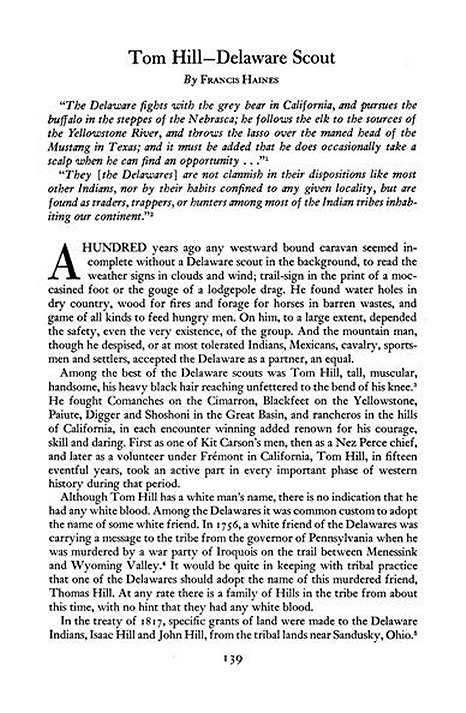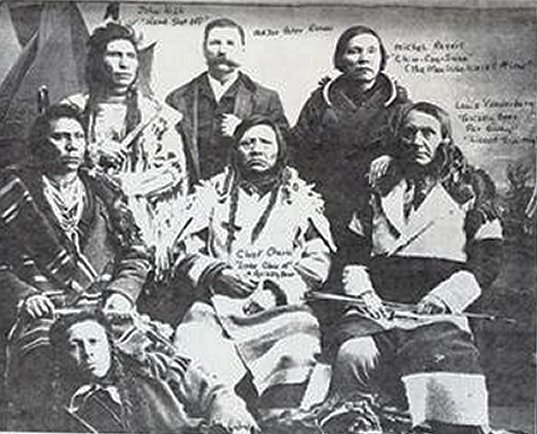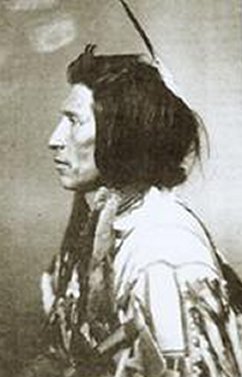![]()
Tom Hill
Scout and Trapper
Compiled by
David Charles “Chalk”
Courchane
October, 2010
![]()
Tom Hill was born about 1813 in the eastern United States where he
grew up witnessing the destruction of the Delaware way of life and the theft of
their land by the Americans. It was due to those memories that he became
involved at Waiilatpu and the Whitman Mission. He was pro-Cayuse and had a Nez Perce
wife. About half the historians call him
a full-blood and the other half say he was half Indian.
As a youngster in the mid-1830's, Jim Delaware (aka Jim Simonds) “ migrated west with 6 other Indian trappers, including Tom Hill. They first trapped their way to California, where they spent the winter. Then they headed north and met some Shoshoni, with whom they stayed several years, continuing to trap. At least at this point Shawnee Jack was with them. About 1839 Delaware Jim and Tom Hill moved on to the Nez Perce, where they both married and had children. Jim had a daughter. After "a long while" among the Nez Perce, Delaware Jim headed eastward toward his old home. Passing through the Bitterroot Valley, he met Ben Kizer, a Shawnee, who was ill and asked Jim to look after him (Schaeffer n.d.; Haines 1946:141). It is said that they were members of John C. Fremont's exploring expeditions in 1843 and were trappers in the Rockies in the 1840s. Although Richard Malouf wrote that Delaware Jim was not with Fremont, there is a Daniel Simonds mentioned in Fremont's journals of his first expedition, two Delawares in his second expedition (noted by Malouf) and there were at least 12 Delawares in his third expedition. Also, Jim Delaware was called Sarcoqie, and Fremont mentions one of the Delaware as Sagundai . A stretch? Maybe and maybe not.
"He came West in 1834 and joined up with
Carson and when silk hats replaced beaver hats about 1839 he was through with trapping. He moved in with his wives people and started
hunting buffalo for a living at the headwaters of the Missouri River. By 1845 they moved back to Idaho and settled
on the Clearwater River." [Land of giants: the
drive to the Pacific Northwest, 1750-1950” by David Sievert
Lavender
While among the Nez Perce he told them of
the evils of the whites and worked on them for a number of years; asking them why they planted potatoes when
they could be hunting buffalo on the plains.

In 1845 the Cayuse asked Tom Hill to come and talk with them. “About this time the station had a visit from a band of Delaware Indians, under the leadership of Tom Hill, who was very intelligent and could speak English as well as Cayuse. Dr. Whitman made a feast for them and invited the leading Cayuses and others. The indispensable item of an Indian feast was corn mush. A large kettle was suspended over a fire in the yard and the mush was made by putting in tallow and stirring in meal or flour. When cooked the kettle was taken indoors and placed on the floor. The doctor was master of ceremonies and the rest came in order of rank. The doctor and the chiefs dipped their spoons in the big kettle, but common people had dishes served and ate out of them. Some acted as waiters. They had tea, sweetened. We children were looking on, and it amused us to see what a quantity of sugar they used & emdash; all that the tea could hold. It was evening and the family occupied a bench on one side of the big room, which was crowded. It was well lighted with candles, and they ate in silence, except the sipping noise peculiar to Indians eating. Their performances at the trencher were so amusing to us that occasionally Mrs. Whitman had to send us outdoors to have our laugh out. When the feast was over the room was cleared and put in order for the speech. Tom Hill delivered an address that lasted two hours and was quite eloquent. We could understand the Cayuse talk, but the Indians did not know it. We were not allowed to learn it, and kept as much as possible away from the Indians, but constantly hearing the language spoken, we could not help but learn the meaning of it, though we could not speak it well. After the massacre they soon found out that we understood their talk. Mrs. Whitman always treated them politely and kindly, thanking them for every little favor they did her." [Across the Plains in 1844 By Catherine Sager Pringle]
O.F. Canfield
remembered as an old man, that when he was a boy on a wagon train coming West
with his father, W.D. Canfield, in 1847 that Tom Hill traveled with them for a
“considerable part of the way." He
considered Hill’s remark as a fundamental cause of the massacre. [Lyman's
history of old Walla Walla County: embracing Walla Walla ..., Volume
1 by
William Denison Lyman
“Bill Gulick says that Tom Hill was a
full-blood Delaware and came out West during the beaver days, trapped with Kit
Carson. He later married a Nez Perce
woman, after which he moved to Lapwai, Idaho about the same time as mountain
man, William Craig. One writes describes
him as “a striking figure with an intense hatred of whites for reasons well
remembered. He could speak eloquently
for hours, and seems to have acquired a following of perhaps a thousand strong
among the Nez Perces, including more than half a dozen chiefs. Whitman suspected that Hill was friendly to
the Catholic priests, but actually he was a thorough going agnostic where the
white man’s religion was concerned.”
The reference to a
thousand followers and 8 or 9 chiefs was written by Lapwai missionary, Henry
Harmon Spalding in a letter home, who called Tom Hill a “a most debased infidel
half breed Delaware, who has been for years in the Mts spreading his
poison.
The message Tom Hill
had for the Nez Perces and all the other Indians of the region was stark and
simple: Kill the whites or they will destroy you.” [Snake River Country,”Part Four - River of Desert 1843-1860 by Bill Gulick,
Caxton Printers, Ltd, Caldwell, Idaho, 1971
In January of 1846, Peo-peo-mox-mox (Yellow Serpent) led
a band of Wallas Wallas and Cayuse to California on a trading and hunting trip, Tom went with them. When the Mexican War broke out he enlisted as
a volunteer at Sutter’s fort. He was put
in a company of volunteers at 25 dollars a month while Peo-peo-mox-mox and nine
of his Walla Wallas were hired as scouts for 6 dollars a month. After the war in which “he fought with
considerable dash”, Tom never returned to Idaho.
He drifted across the Plains to Kansas and settled among the Delawares
there. He died here according to David
Lavender.
During the Nez Perce War in 1877 there was mention of a Tom Hill. He and others were told to go into the prairies and look for fleeing Nez Perce, he obeyed and left for good. [U.S. Senate, Memorial of the Nez Perce]. Who was the Tom Hill? One of Tom Hill, Seniors sons?


According to Troy Felsman, "John Hill or ` Hand Shot Off' was the son of Tom Hill. He
is in the pic with Charlo, Louis Vanderberg, Abel Adams, Michel Revais and Major
Ronan taken in DC back in 1884. I think he was half Delaware and Half Nez Perce
or Salish although raised with the Salish."
(Note: Email 6 may 2002
From mbk414@camasnet.com (this proved to be no longer good) Marci Bailey of Henry and
Marci Bailey, says she's a descendant of Tom Hill. She lives in Idaho and is Nez
Perce)
![]()
My name is Stephenie Flora.. Return to [ Home Page ]. All [ Comments and Inquiries ] are welcome.